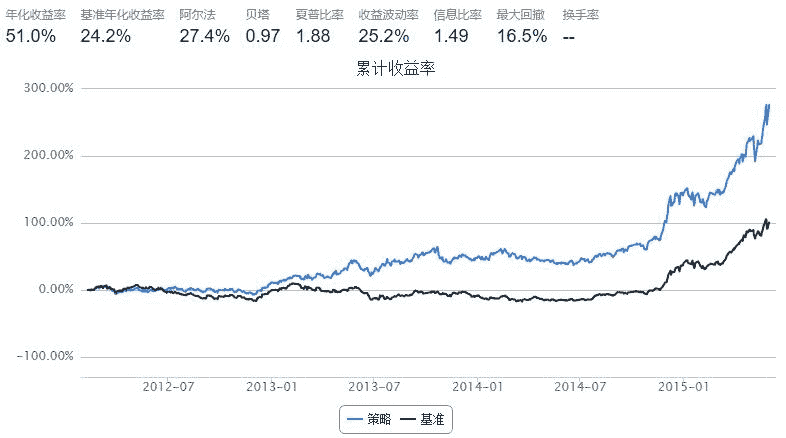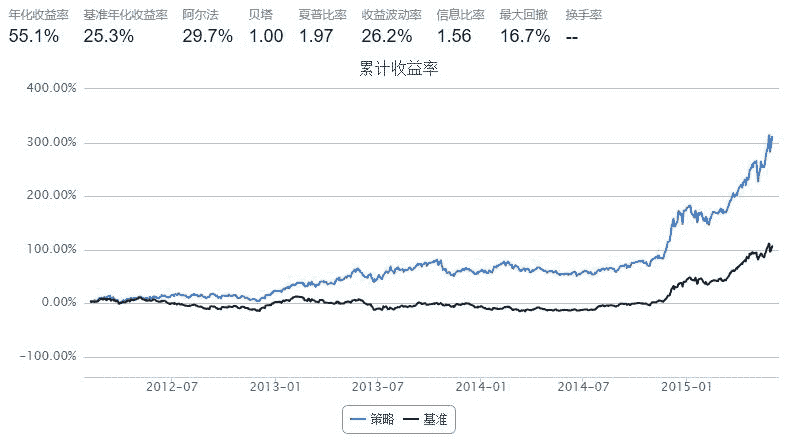[量化策略]Sharpe_Momentum (夏普率动量策略)
来源:https://uqer.io/community/share/5656bd13f9f06c4446b48875
1. Introduction
众所周知,动量策略是量化选股中非常经典的模型。
思路是:从股票池中选取过去一段时间表现最好(收益率最高)的部分股票,等权重买入,到下一个调仓日清仓。然后周而复始。
与之相应的还有一个叫做“反转策略”,即认为投资者有抄底心态,过去表现最不好的股票将否极泰来。
2. Parameters
这类模型有以下几个参数可以调整:
1)换仓频率
2)过去表现的周期设定(即设定之前的多少天作为衡量基准)
3)股票池的选取:全部A股?或是弹性更高的中证500?或是流动性最好的上证50?
4)按照过去表现排序后,选择其中哪些股票?(Top 20%?Top 10%?或是中间的一部分?)
可以说,这类模型思路简单,逻辑明晰,参数变量少,是很棒的入门级策略
3. Development
无论动量策略或是反转策略,都只考虑收益的变化,而对该收益率所承担的风险不闻不问。
笔者从夏普率的维度去看待动量策略,直觉上认为前一段时间夏普率高的股票将延续这一势头。(此处不考虑无风险利率)
PS:关于夏普率如何计算,可参考笔者的”[量化基础]如何计算夏普率“一文
import numpy as np
import pandas as pd
start = '2012-01-01'
end = '2015-06-01'
benchmark = 'HS300'
universe = set_universe('HS300')
capital_base = 10000000
refresh_rate = 10
def initialize(account):
pass
def handle_data(account):
window = 20 #回望表现周期
history = account.get_attribute_history('closePrice', window+1) #多取一天收盘价,为了计算window个收益率
history = pd.DataFrame(history)
sharpe = {'symbol':[], 'ratio':[]} #设置一个字典
for stk in account.universe:
sharpe['symbol'].append(stk) #字典中的symbol段 储存股票代码
ret = history[stk].pct_change() #之前讲history转化成DataFrame结构,方便计算
ratio = ret.mean() / ret.std() #夏普率简化为平均收益/收益波动率,也不年化了,反正排序后效果是一致的
sharpe['ratio'].append(ratio)
# 按照过去window日收益率排序,并且选择前20%的股票作为买入候选
sharpe = pd.DataFrame(sharpe).sort(columns = 'ratio').reset_index()
sharpe = sharpe[len(sharpe)*4/5:len(sharpe)]
buylist = sharpe['symbol'].tolist()
for stk in account.valid_secpos:
if stk not in buylist:
order_to(stk, 0)
# 等权重买入所选股票
portfolio_value = account.referencePortfolioValue
filteredBuylist = []
for stk in buylist:
if not np.isnan(account.referencePrice[stk]):
filteredBuylist.append(stk)
#print account.current_date, filteredBuylist
for stk in filteredBuylist:
if stk not in account.valid_secpos:
order_to(stk, int(portfolio_value / account.referencePrice[stk] / 100.0 / len(buylist))*100)

4. Comparison
同样的设定我们与下面的动量策略做比较
import numpy as np
import pandas as pd
start = '2012-01-01'
end = '2015-06-01'
benchmark = 'HS300'
universe = set_universe('HS300') # 股票池为沪深300
capital_base = 10000000
refresh_rate = 10
def initialize(account):
pass
def handle_data(account):
history = account.get_attribute_history('closePrice', 20)
momentum = {'symbol':[], 'c_ret':[]}
for stk in account.universe:
momentum['symbol'].append(stk)
momentum['c_ret'].append(history[stk][-1]/history[stk][0])
# 按照过去20日收益率排序,并且选择前20%的股票作为买入候选
momentum = pd.DataFrame(momentum).sort(columns='c_ret').reset_index()
momentum = momentum[len(momentum)*4/5:len(momentum)] # 选择
buylist = momentum['symbol'].tolist()
for stk in account.valid_secpos:
if stk not in buylist:
order_to(stk, 0)
# 等权重买入所选股票
portfolio_value = account.referencePortfolioValue
filteredBuylist = []
for stk in buylist:
if not np.isnan(account.referencePrice[stk]):
filteredBuylist.append(stk)
#print account.current_date, filteredBuylist
for stk in filteredBuylist:
if stk not in account.valid_secpos:
order_to(stk, int(portfolio_value / account.referencePrice[stk] / 100.0 / len(buylist))*100)

5. Futhur Discussion
无论是夏普率动量策略,或是收益率动量策略,表现看上去都是那么完美
但是!
但是!
但是!
一旦把2015年6月开始股灾放进回测区间,那么效果瞬间大打折扣
该策略还有许多值得改进之处,各位朋友发挥脑力吧。
疑问:比较两个策略,回测周期一致,基准一致,那么为什么基准年化收益率会不同?

